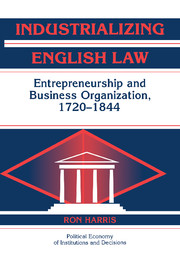Book contents
- Frontmatter
- Contents
- List of Tables
- Acknowledgements
- Introduction
- 1 The Legal Framework
- PART I BEFORE 1720
- PART II 1721–1810
- 4 Two Distinct Paths of Organizational Development: Transport and Insurance
- 5 The Joint-Stock Business Corporation
- 6 Trusts, Partnerships, and the Unincorporated Company
- 7 The Progress of the Joint-Stock Organization
- PART III 1800–1844
- Conclusion
- Appendix 1 The Rise and Decline of the Major Trading Corporations
- Appendix 2: Capital of Joint-Stock Companies Circa 1810
- Bibliography
- Index of Cases
- Index of Statutes
- General Index
4 - Two Distinct Paths of Organizational Development: Transport and Insurance
Published online by Cambridge University Press: 12 August 2009
- Frontmatter
- Contents
- List of Tables
- Acknowledgements
- Introduction
- 1 The Legal Framework
- PART I BEFORE 1720
- PART II 1721–1810
- 4 Two Distinct Paths of Organizational Development: Transport and Insurance
- 5 The Joint-Stock Business Corporation
- 6 Trusts, Partnerships, and the Unincorporated Company
- 7 The Progress of the Joint-Stock Organization
- PART III 1800–1844
- Conclusion
- Appendix 1 The Rise and Decline of the Major Trading Corporations
- Appendix 2: Capital of Joint-Stock Companies Circa 1810
- Bibliography
- Index of Cases
- Index of Statutes
- General Index
Summary
In Chapter 1, I surveyed a variety of organizational forms of business. In Chapters 2 and 3, I outlined the emergence, not without interruptions, of the joint-stock business corporation, from the mid-sixteenth century to the early eighteenth century. In the present chapter, I address the question of why the variety of forms persisted during the eighteenth century, whereas the joint-stock corporation did not gain dominance. In other words, why was a convergence process not observed, in which entrepreneurs transformed their existing undertakings, or at least their new ones, into joint-stock business corporations – obviously the natural candidates for this dominant position (particularly as we know the end of the story)?
Three major explanations for the persistence of this diverging path are explored in this and the following chapters. The first explanation is that the joint-stock corporation is not superior, in terms of efficiency, as some modern theoretical jurists and economists believe. The second is that the preconditions for exploiting its efficiency, an industrial economy with large-scale production and an effective share market, did not exist in eighteenth century England. The third is that there were legal, political, and other constraints that prevented businessmen from organizing in joint-stock corporations.
In the present chapter, I focus on two sectors, transport and insurance, and describe their divergence during the eighteenth century into two distinct organizational patterns: the first toward the joint-stock corporation and the second toward the unincorporated joint-stock company. I argue that the reasons for their divergence are rooted in systemic constraints.
- Type
- Chapter
- Information
- Industrializing English LawEntrepreneurship and Business Organization, 1720–1844, pp. 85 - 109Publisher: Cambridge University PressPrint publication year: 2000



